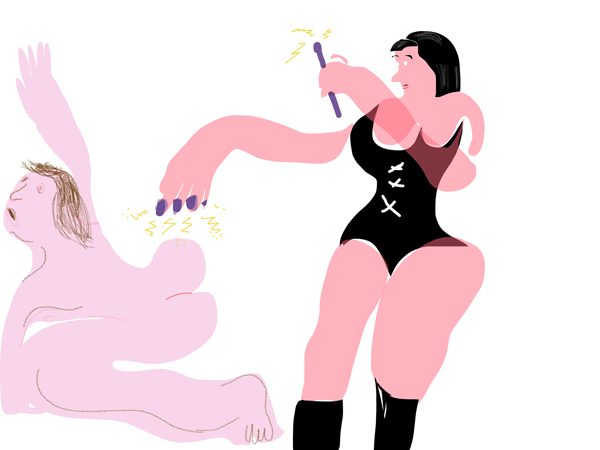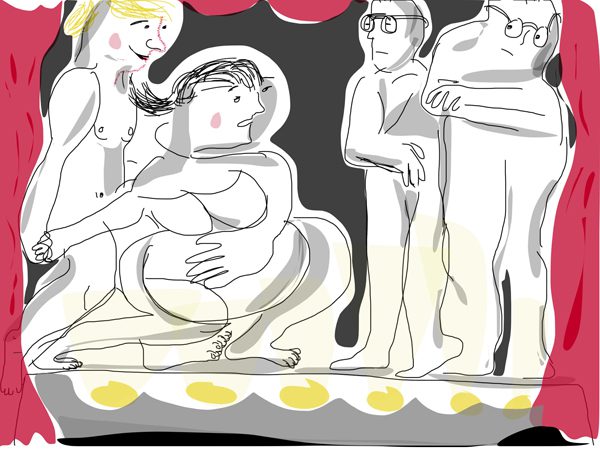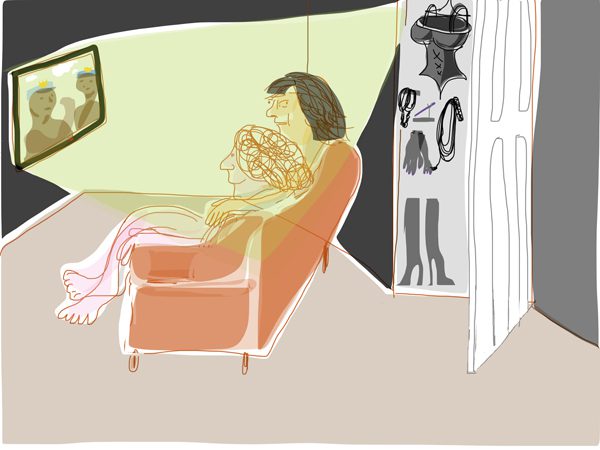
There’s evidence that D.H. Lawrence enjoyed an erotic power exchange relationship with his wife, that James Joyce was into scat (among other things), and that Oscar Wilde—well, most of us know what Oscar Wilde liked. These literary geniuses explored radical sexual agency and desire in their work and in their relationships, but little beyond rumors and personal letters exist to tell us what they themselves thought of their turn-ons and the ways in which those dovetailed with their writing. Even if space for such a discourse and community had existed back then, Lawrence, Joyce and Wilde couldn’t freely discuss their sexuality. As it was, they faced censorship and generated scandal wherever they went, and of course Wilde went to prison for his sexual behavior.
Although our world is still intolerant of sexual difference, I want to believe we’re at a point where people can speak openly about the consensual ways we express our erotic selves. And I’m interested in the connections between those private expressions and the larger, more public work we do in the world. This series is meant as a forging of community; a validation of that which gets called sexual deviance; and a proud celebration of the complex, fascinating ways that humans experience desire.
In this ongoing series of short personal essays, writers in all genres—novelists, poets, journalists, and more—explore the intersection between our literary lives and practices and our BDSM and fetishistic lives and practices. In other words, these essays aren’t about writing about non-normative sex: rather, it’s a series about how looking at the world through the lens of an alternative sexual orientation influences the modes and strategies with which one approaches one’s creative work.
If you have questions or comments, or if you’re a writer who would like to contribute, please contact me at kinkwriting@gmail.com.
–Arielle Greenberg, Series Editor
***
Writing Consensual Non-Consent
Summer 2014. I’m walking down Bedford Ave with a girl I’ve been casually electrocuting. We stop in a boutique selling rhinestone-embellished hair accessories in the middle of a conversation about one of BDSM’s most controversial topics—consensual non-consent.
“Why would I give you permission to do something to me if I don’t know what it is?” she asks, picking up a bedazzled headband and eyeing her reflection in a small mirror.
“Because you’ll like it,” I say, pulling back her hair and swapping out the glittery piece for a simple cream-colored bow. “Because you trust me.”
We walk out of the store and weave up and down the side streets of Williamsburg on our way back to her house. We stop at a deli for cigarettes and chain-smoke outside of a coffee shop.
“It’s a real thing,” I say. “It’s called consensual non-consent. It can mean a lot of different things for different people, but one way to play with it—the way I want to play it with you—is that whenever we’re together, you agree to give up your right to say no. That way, you won’t have to think so much when we play. You can be totally inside of your body, inside of the experience. You won’t freak out so much.”
She looks at me with absolute skepticism. I’m at the tail end of my tenure working as a pro domme, a professional dominatrix, which had piqued the girl’s interest in kinkier sleepover activities. When I had walked out of an electrocution session and into The Leatherman in Chelsea a few weeks earlier, the only store in the city where I could purchase a violet wand with a body contact attachment that would allow me to electrocute submissives with my fingertips, I texted her a picture of the sleek white box. I took the G train to her apartment that same night, let her drink a glass of bad Chardonnay while I plugged in the machine and sent her dog out of the bedroom to chase an errant sock.
to electrocute submissives with my fingertips, I texted her a picture of the sleek white box. I took the G train to her apartment that same night, let her drink a glass of bad Chardonnay while I plugged in the machine and sent her dog out of the bedroom to chase an errant sock.
After that, we started spending a lot of time together. I would go to her apartment and electrocute her until she was ready to sleep, and in the morning she would make me coffee while I painted and played fetch with her dog. She was the perfect submissive; well, she could have been. But she was unwilling to give herself over entirely, and it annoyed me. I was used to unwavering devotion from my professional clients. This is why, I thought, I don’t play privately.
Now she says, “I don’t know. I don’t know. I don’t think so.”
“You don’t have to say yes right now, but think about it.”
We never get past her wariness of consensual non-consent (CNC) and we stop playing before we stop talking. We can’t agree on comfortable boundaries and the play gets stale and boring very quickly. A few weeks later I start dating someone else and stop seeing the girl.
*
The first time I heard of consensual non-consent, it was in a book of essays left in my best friend’s apartment by another writer who also dabbled in sex work. She lived with my friend for a few months and left behind a thick, glossy paperback called The Ultimate Guide to Kink: BDSM, Role Play, and The Erotic Edge. She also left a black PVC tank top, which I would wear on my first day as a dominatrix. In The Ultimate Guide to Kink, there’s an essay dealing with consensual non-consent, a particularly graphic piece of writing which details a married D/s duo engaged in bloodlettings in your typical scary-sounding dungeon scene. This was a piece about true sadism as much as it was about CNC. It scared me—I am not a sadist—but I was intrigued by the concept of having complete control over another person’s mind and body, of being more powerful, even, than the ubiquitous “safeword.”
Early on in my professional career, I experimented with certain submissives. Before any pro domme session, I sat with the client in a small conference room, in armchairs, like civilized people, wearing our street clothes. Often, we would script a session from beginning to end, leaving little room for unauthorized activities. But in a few cases, even in the conference room, a client would sink to their knees at my feet and beg to have their consent taken away. These were my most fun and creative sessions; often they involved animal training, age regression, or cross-dressing. I could turn a client into a dog and make them drink a bowl full of saltwater.
*
January 2013. I’m sitting in my best friend’s bathtub dressed like a medieval stable boy, playing Fleetwood Mac songs on the ukulele. I get up and walk into the kitchen, cut a tangerine in half, stick it in the bottom of a rocks glass, and pour Pisco on top. I drink the whole thing at once and sit down on the chaise with my laptop.
“I’m going to write a play called Two Genius Husbands,” I announce. “It’s going to be about the impossibility of being intelligent and in love.”
*
Dramatic dialogue is a weird beast. To write it convincingly, with the odd cadence of natural speech, so many rules must be already in place before a single word is written down. I heard the aural patterns in my head before I knew what the characters in Two Genius Husbands would be talking about. I set up a system for them to navigate. I had written plays before, dense and difficult exercises using the theatricality of the Language poetry that was my obsession when I was in school. I had wanted to explore the aural tradition of poetry through the performative conventions of theatre. In the case of Two Genius Husbands, I wanted to create a sort of Rosetta stone that would translate the impossibility of being a person obsessed with language and theory—the key to their codified language would be its rhythm.
So: Q and Q would be interchangeable entities of pure intelligence. They would also be co-dominants in a TPE (Total Power Exchange) relationship with Eleanor, their “maid.” The action of the play would center around two major transgressions on Eleanor’s part: she would come home with a stranger, named Dodger, only to later reveal that she was pregnant by another (unseen) stranger. Dodger would be The Fair Unknown of Medieval literature, with a brash and chivalrous nature that was a composite of two women I loved at the time.
By using the dynamics of a complex BDSM relationship to create the world of the play, I was able to write these very odd characters with a sense of ease. Consensual non-consent is a key factor in Total Power Exchange structures, which is a kind  of 24/7 consensual non-consent. In these relationships, the submissive party agrees to relinquish all control over their own life to the dominant party—or in this case, parties. In turn, the dominants have a responsibility to protect the submissive and act in their best interests.
of 24/7 consensual non-consent. In these relationships, the submissive party agrees to relinquish all control over their own life to the dominant party—or in this case, parties. In turn, the dominants have a responsibility to protect the submissive and act in their best interests.
The services which Eleanor performs for Q and Q are not explicitly outlined in the text of the play, so the nature of her submission is fluid. The actors, director, and production team are left with the task of deciding whether she is scantily clad and chained to the ankle of one of her masters, or whether their relationships appears to be a normal poly household from the outside only to reveal its subversive nature through small actions: glances, flicks, asides.
What is implied in this particular situation is that Eleanor is a pseudo-student who has entered into this TPE relationship in order to achieve self-improvement. When she breaks the rules of the relationship by exercising agency over her own body (pregnancy) and seeking out a father-figure for her child, she negates the CNC. To create the action of the play, I created a rigid structure, and then allowed one of the characters to break its most fundamental rule.
*
At the time of this writing, I am in the midst of the rehearsal process for the second development workshop of Two Genius Husbands. In the first performance, Q, Q, and Eleanor were all played by women in their mid-twenties, and Dodger was played by a male actor of a similar age.
The actors in the first cast all attended the same MFA program as the director, and the cast had a particularly academic approach to preparing for the performance. During the rehearsal process, there was much discussion of meaning. Things were cut and changed, as is wont to happen when a new play is in development. The actors brought life to details in the piece that even I had never noticed. The central relationship of the play was uncharted territory for the cast, and to watch straight, cis-gendered actors navigate its complex waters was fascinating.
Over the course of the month-long rehearsal process, this inaugural cast interacted with the text much in the way that Eleanor interacted with the Qs. At first, they were intimidated into submission by the language and the narrative, trying to fit themselves into its structure, searching for “understanding.” Within a week or so of the performance, though, the tables had turned. The actors were beginning to question to the rules of this world, the logic of the structure—but they had signed up for CNC, as all actors do.
The nature of acting is submission: to the confines of a character, the prescience of a writer, the whim of a director. An actor must have an incredible sense of self, of self-control, as must the ideal submissive. Ultimately, one is confined to the linguistic rope work created by the playwright. Of course, it is more enjoyable for everyone when the actors push and struggle against their bondage. This is what gives life and humanity to a performance.
It was only about halfway through the rehearsal process that I told the actors explicitly about the BDSM relationship within the play. Because the stage directions and properties of the play are intentionally vague in order to allow for each individual production to be unique, there are no obvious trappings of SM—no flogging scenes, no whips or handcuffs. The information is there, but it’s coded; those who aren’t in the know might miss it. This knowledge totally changed their understanding of the characters and their motivations.
A second production of the play was mounted a few months later for a theatre festival on the Lower East Side. In this version, Q and Q were played by male and female actors in their fifties, while Eleanor and Dodger were played by male and female actors in their mid-twenties. I mention this difference because there is a sense, too, in which the playwright in writing a play is also engaging in a relationship of consensual non-consent. In my own mind, Q and Q are female, but I intentionally left their genders ambiguous in the text of the play. I wanted to submit to the collaborative nature of theatre-making, to allow others to enact their will upon my creation. When this second production was cast, I initially felt the desire to resist. But I understood the nature of the contract I had signed.
During our discussion after the first read-through with the second cast, I decided to tell the actors right away about the BDSM connection. Almost instantly, I could see them understanding the words they had just said with increased clarity.
*
Winter 2015. My girlfriend and I are preparing for the snowstorm of the century by ordering cases of Pellegrino on Amazon Prime Now. She is calling me ridiculous while I panic and check the status of nonperishable items in the kitchen. I haven’t been able to finish the play I’ve been writing. Now that I’m in love and subject to the will of increasingly harsh winters I feel totally powerless and lost. I don’t know how to operate within the confines of happiness. I am uncomfortable in the face of natural disaster, in the face of anything I can’t control.
This is why D/s situations appeal to me, why writing appeals to me: I love to construct the world I live in. This is also what makes CNC both appealing and terrifying, depending on the perspective.
I open a document on my computer and write the last scene of Two Genius Husbands while I wait for the city to be buried in snow. My girlfriend and I stay up late and the storm never comes. In the morning I have to go into work despite the fact that the MTA has been shut down.
Later, I re-read the play from beginning to end. When I started writing the play, my life had no structure. I needed to create a world reliant on rules in which I could exist. But the rules of the fictional world were not enough to hold me up in real life, and not enough to allow me to close the circuit of the play. I needed my body to exist inside of a real structure.
Now that I am in this relationship, I am no longer solely responsible for basic decisions: go to the bodega down the street for a bacon egg and cheese sandwich or starve? Domesticity is a kind of submission. My girlfriend and I wake up and we cook breakfast. This is not a topic up for debate, because she, unlike me, cannot imagine languishing for languishing’s sake.
For most of my adult life, I only dated writers, or engaged with non-writers in kink-focused relationships. I was convinced that without one of these two components, no human could possibly understand me, dark and twisted as I generally consider myself to be. However my partner now, my partner for life, is not a writer, and is generally vanilla.  When I moved into her apartment, my violet wand, floggers, and handcuffs were relegated to the back of a closet. My corset collection freaks her out; she’s convinced that pulling the strings too tight will break my ribcage.
When I moved into her apartment, my violet wand, floggers, and handcuffs were relegated to the back of a closet. My corset collection freaks her out; she’s convinced that pulling the strings too tight will break my ribcage.
Learning how to write, how to live, in this situation felt more deviant than the most disturbing dungeon scenario of my pro domme career. A poet—a kinky, poly poet—in a happy, stable, vanilla, monogamous relationship? Impossible! But after a few months, it became apparent that this could be a new kind of kink, a new kind of CNC. Living like this, there are different constraints to lean into, different power dynamics to discover. When I waive my consent, I construct for myself the most frightening situation imaginable. I willingly and totally give up control. When I convince a partner to waive their consent, I am able to see firsthand that giving up control to someone you trust is not only survivable, it’s liberating.
BDSM, like writing, can be so self-serious. By letting go of my formal commitment to both, I found ways to release my expectations, and as a result, let them back into my life in healthier and more fulfilling ways. When I stopped worrying about whether or not my newly vanilla sex life was doing a disservice to my essential self, I rediscovered the most essential element of BDSM—play. Without the ritual and formality of dungeons, props, and contracts, my partner and I began to learn how to play together, in a way that is totally unique to us. And when I wasn’t laser-focused on writing as a lifestyle, I suddenly found that I could write freely again.
***
Rumpus original logo and art by Liam Golden.




